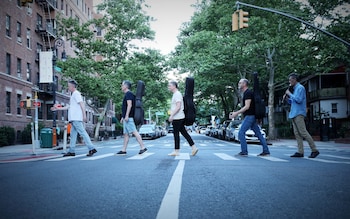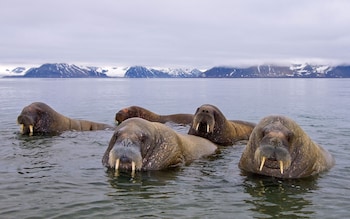Audrey Flack, who has died aged 93, enjoyed an eclectic career as an artist, swimming against the tide of the avant garde and celebrating kitsch, which she defined as anything the art world considered “too sentimental, too glitzy, with too much colour and too much emotion”, or in other words, “something that people can relate to”. She treasured the verdict of a critic who declared that “Flack’s work is in overt defiance of good taste.”
Had politics not intervened, she would also have been the creator of New York’s tallest statue after the Statue of Liberty, and the largest public statue made by a woman anywhere in the world.
In 1998, her enormous bronze of Charles II’s Portuguese wife Queen Catherine of Braganza, after whom the New York borough of Queens is thought to be named, was at the foundry, and nearly cast. It stood 35 feet high – equivalent to a six-storey building – and was destined for a spot on the East River, facing the United Nations building. Audrey Flack had worked on it for nearly a decade.
But activists protested that Queen Catherine, as part of the English court and a subscriber to the Royal African Company, would have benefited from slavery.
Audrey Flack pointed out that she had asked a mixed-race cousin to sit as her model for the sculpture, to represent the diversity of the borough of Queens, because Catherine of Braganza herself “had dark Portuguese skin and was made fun of for that.”
But pressure mounted, and despite the interventions of academics who also noted that the queen had left money in her will to help free slaves, the project was cancelled and the almost-finished bronze statue melted down for scrap.
Audrey Flack was born in New York on May 30 1931, the daughter of Jewish immigrants from eastern Europe. Her brother, serving in the Second World War, was one of the first soldiers to liberate the Eagle’s Nest, and smuggled home some of Hitler’s watercolours. She was impressed by the Führer’s technique.
Her mother was a gambling addict, and Audrey was frequently left alone in the flat, where reproductions of Ghirlandaio, Rembrandt and Van Eyck hung next to work by the Playboy illustrator and airbrush-wielder, Alberto Vargas. Her own approach to art would replicate this unlikely juxtaposition of Old Masters and “pop” imagery.
She started as an Abstract Expressionist, in the Cedar Bar circle of Jackson Pollock, Franz Kline and Willem de Kooning. Pollock, whose stubble made him look like “a porcupine shooting out prickly quills to protect itself”, tried to sleep with her, but she found his temper frightening. Whereas the Abstract Expressionists thrived on chaos, she recalled in her memoir, “I wanted stability. Art was the most important thing in my life, but I wasn’t going to let it kill me.”
She became, unfashionably, a realist, treating subjects like The Three Graces in an update Baroque style. She then became a leading light (and the only woman) in the new photorealist movement of the 1960s, when she controversially embraced the commercial illustrator’s tool of the airbrush.
Unlike her fellow photorealists, who painted unemotional, banal subjects such as trucks and skyscrapers, she created elaborate modern vanitas pictures of female dressing-table junk, stuffed with emotionally charged symbols of vanity and mortality, such as Jolie Madame (1972), a massive canvas which depicts wilting flowers, jewellery and scent bottles, or Marilyn (Vanitas) (1977), which shows a photograph of Marilyn Monroe with a shrivelling orange, an hourglass and a burning candle.
Her overtly feminine sensibility attracted unfavourable comment, both from the feminist movement and from the largely male art press. When the Metropolitan Museum of Art bought her Leonardo’s Lady (1974) – making her the first photorealist to enter its permanent collection, ahead of her peers Chuck Close and Wayne Thiebaud – the New York Times critic Hilton Kramer denounced her as the “brassiest of the new breed” of realist painters, and “the Barbra Streisand of photorealism”.
A turning point in her life had been discovering a weeping 17th-century wooden sculpture of the Virgin Mary by the female Baroque artist Luisa Roldán. “I didn’t care that this art was dismissed as lower-class kitsch,” she recalled. “I loved it.”
In the early 1980s her work took a turn into spiritual kitsch – breaking ground where Jeff Koons, the Chapman brothers and Gilbert and George would later follow. Salvador Dalí showed up to her exhibition with a leopard on a chain. Again, the New York Times called her work “irredeemably hideous”, but Audrey Flack was happy to be out of kilter with the establishment.
“Art world kitsch with all its sparkles, glitter and bangles will not be taken seriously by the ‘people’ out there, mainly because it is not sentimental or whatever sentiment is in it is covered up by a ‘camp’ or humorous attitude,” she wrote. “On the other hand, popular kitsch is not taken seriously by the art world, because it takes itself seriously and is sentimental and romantic, two attributes which are looked down upon in the current art world. This re-raises the question – just who is art for?”
She then abandoned painting to revive the 19th-century discipline of monumental bronze figurative sculpture of mythic females.
In her final phase, which she called “Post-Pop Baroque”, she returned to drawing, embracing an aesthetic that owed something to pavement art, mashing together Dürer’s Melancholia with Wonder Woman, or Rubens’s The Garden of Love with Superman and Supergirl.
In 2022, two of her paintings in response to Carlo Crivelli, a much-misunderstood Renaissance master whom she revered as a “Gothic, Baroque Super-Realist”, were exhibited at the Ikon Gallery, Birmingham.
By her abusive first husband, Audrey Flack had two daughters (one of whom was severely autistic), but she concealed them from the art world in order to be taken seriously. She was so short of money that she paid her obstetrician in paintings.
She divorced in 1968 and in 1970 married her high school sweetheart Bob Marcus, who adopted her daughters.
Audrey Flack, born May 30 1931, died June 28 2024
Disclaimer: The copyright of this article belongs to the original author. Reposting this article is solely for the purpose of information dissemination and does not constitute any investment advice. If there is any infringement, please contact us immediately. We will make corrections or deletions as necessary. Thank you.




